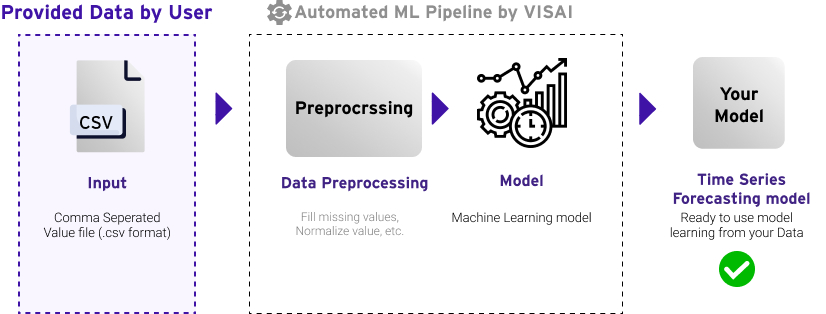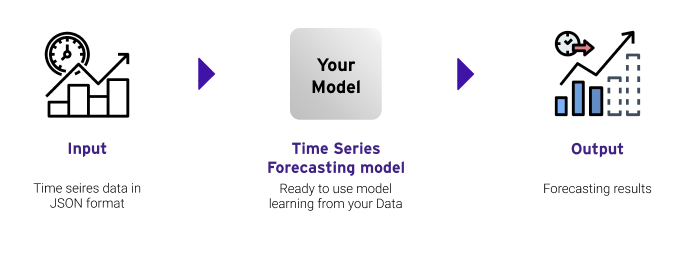¶ Time Series Forecasting
AI predicts future values based on historical data, mainly used in finance and retail.
Beta version: The platform is in a development stage of the final version, which may be less stable than usual. The efficiency of platform access and usage might be limited. For example, the platform might crash, some features might not work properly, or some data might be lost.
¶ Training model

For “Customized AI" mode: you are required to prepare only a dataset for training in case you want to train your model.
¶ Input
The input data should be in a format of ‘comma separated value’ file (.csv format). In other words, the input data is shown as a table data separated by “,”. After having uploaded dataset, a user is required to select types of data for each column. The detail of possible column types is presented as follows:
- Timestamp contains timestamp for each datapoint in a dataset. The timestamp column must have only one column in each dataset.
- Categorical feature contains category data type that is a feature for a model in a dataset.
e.g., Weekend column feature that contains [“Yes”, “No”] value. - Numerical feature contains numerical data type that is a feature for a model in a dataset.
e.g., Price column feature that contains [30, 25, 21, 14, ….] value. - Target (Required) contains numerical data for prediction.
- None for the column that will not be used for model training.
**Noted: the data should be sorted in time order.**
¶ Model Training Setting
- Column type for each column, before training the model.
- Predict step which is the number of timesteps that a model can predict values. (The default value of predict step is 1 and the maximum of predict step is 20 steps). For example, if we select 5 predict steps, it means a timeseries model will forecast values for 5 steps in future.
¶ Data preprocessing
Time series data will be processed according to the following steps:
- Remove timestamp
- Fill missing values with interpolate method
- Standard scaler with all numerical features
- Encode in all categorical feature
- Feature extraction with sliding window transformation
All these preprocessing methods are done by using sktime library.
¶ Model
Time Series Forecasting model is a regression model that learns by a tabular data format prepared from the time series input. The ACP ML pipeline for time series forecasting would train three algorithms to build a machine learning model in parallel. The algorithms consist of linear model, kernal-based model, and tree-based model. After all algorithms were trained, the platform would automatically pick the model from an algorithm that has the best performance for prediction.
¶ Model Evaluation
For a time series forecasting, we use MAE, RMSE, MAPE and MASE to evaluate a model. Generally, lower MAE, RMSE, MAPE and MASE means better performance.
¶ Using approach

¶ Input
The Time Series Forecasting model receives lists of the Key-value of data when the key is represented by the data column and the value is represented by data in the column in each row. The API JSON input format is shown below.
{
"inputs": [
{
"Column A": Value 1,
"Column B": Value 1,
"Column C ": Value 1,
"Column D ": Value 1
},
{
"Column A": Value 2,
"Column B": Value 2,
"Column C ": Value 2,
"Column D ": Value 2
},
….
]
}
¶ Tips on using the model
There are 2 crucial criteria for using a time series forecasting model:
- The columns of input must be the same as the columns of the training data.
- The number of data point should have at least the same number of back steps.
* Back step is the number of data points that are required from the ACP to predict values. A back step will be presented after training the model.
¶ Output
The response of the Time Series Forecasting model API will be shown as a JSON format, containing:
- Forecast Step is the number of time steps in the prediction. For example, you need to predict a price (the frequency unit is in months) for the next 3 months; the forecast step is 3.
- Forecast Values is the predicted values from the model.
- Data Drift is the difference between the distribution of training data and inference data. The data drift will show the percentage in the number of features of training and inference that drifted. For example, when the number of features is 10 and the data drift indicates 20 percent, this means 2 out of 10 in the number of features are drifted. The lower percentage of data drift means less difference between training and inference data distribution. However, if the percentage of data drift continues to rise[TS1] [JW2] , we suggest you retrain your model with the latest data.
The example of API response would be in the following:
{
“Forecast step”: [1, 2, 3, 4, 5, 6, 7] // List [value]
“Forecast values”: [<predict1>, <predict2>, <predict3>, …] // List [value]
“Data drift”: <percent drift> // Float
}